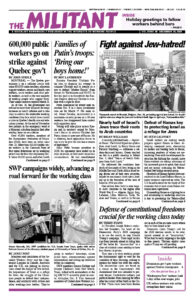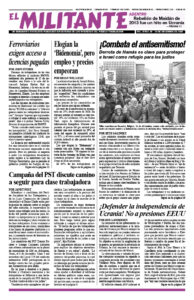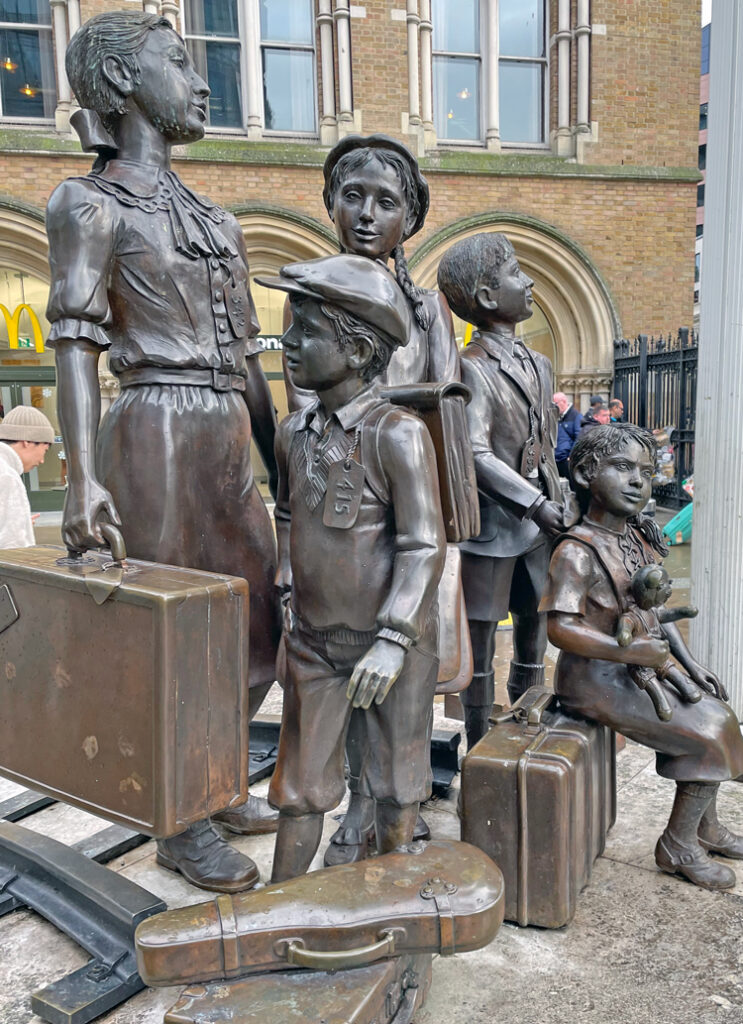LONDON — Kindertransport, the evacuation to the U.K. of 10,000 mainly Jewish children fleeing Nazi persecution in 1938-39, is touted by capitalist politicians and the media as an example of the British government coming to the aid of the Jewish people.
The children came from Germany, Czechoslovakia, Austria and Poland over a 10-month period beginning in December 1938. But, “there is history and there is myth,” Andrea Hammel writes in The Kindertransport — What Really Happened, just published by Polity Press. Hammel is a professor of German at Aberystwyth University in Wales. She presented the book at the Wiener Holocaust Library here Dec. 6.
The library itself had been the target of a Jew-hating attack Nov. 2 when its entry sign was spray-painted with the word “Gaza.”
The library is currently featuring an exhibit titled “Expelled! The History of the Polenaktion,” which marks the 85th anniversary of the mass expulsion of 25,000 Jews from Germany to Poland by the Nazis in 1938. Some participants at the book presentation took the opportunity to visit the powerful exhibit, including this correspondent.
“I wrote the book to make a critical history of the Kindertransport available to a wider audience,” Hammel said, describing the real record of the immigration policies of successive U.K. governments before the Kindertransport program began. The Aliens Act of 1905 was adopted to limit Jewish immigration after tens of thousands of Russian and Eastern European Jews arrived “to escape anti-Semitic pogroms and persecution after 1880,” she writes. Further legislation in 1914 and 1919 added more restrictions.
“It is a fact that in the 1930s the U.K. government’s policy was not laying the foundation for a noble tradition. It was mainly concerned with keeping refugees fleeing Nazism away,” she said.
Between 1933 and 1945, an annual average of just 6,000 Jews were permitted entry. London also put strict limits on Jews trying to get to British-controlled Palestine.
With more and more press reports of the Nazi terror, pressure grew on the capitalist rulers to do something. That intensified with the pogrom in Germany over the night of Nov. 9-10, 1938, known today as “Kristallnacht,” the beginning of the Nazi’s “Final Solution” — the drive to exterminate the Jewish people.
Kindertransport was the British government’s response, a visa waiver scheme for unaccompanied children under the age of 18, reduced after a few months to under 17. It lasted less than a year, ending when London declared war on Germany Sept. 3, 1939.
The government demanded that Jewish parents had to put up 50 pounds for every child admitted — equivalent to 3,500 pounds ($4,400) today — a cost that many families could not afford. The only children permitted had to be “self-supporting, of good character and with robust good health,” Hammel said. Those with signs of mental or physical illness were excluded.
Hammel pointed out that funding and organization for the program was left by the government to charities and other voluntary organizations, often Jewish. There were many more applicants than the 10,000 who got in.
Through research and interviews over 20 years, Hammel has detailed the experiences of many of the children. Families fleeing persecution wanted to emigrate “as a unit” she said. But the scheme ripped families apart — leaving parents to face the Nazi terror. The youngest refugee was a 6-month-old baby. Siblings who arrived together were often separated. Only a minority would ever see their parents again. Hammel cites the example of Renate Collins — not one of her extended family of 64 survived Hitler’s death squads.
A number of children were housed in camps, boarding schools and children’s homes, often in terrible conditions. Some 200 boys and girls were sent to Gwrych Castle, near Abergele, Wales, without electricity or adequate food and with scant sanitation. Two children from Berlin, Anne and Horst Marschner, who were deaf, somehow managed to circumvent the “disabilities” criterion but ended up placed in facilities with no provision for someone who was deaf.
Those placed in family homes had to get to know foster parents who spoke a different language and were not Jewish. Next to nothing was organized to deal with the trauma of having been “persecuted, uprooted and separated from their parents.”
“The forcible estrangement of child refugees from their background can only be described as criminal,” Hammel writes. Many foster parents were well-meaning. Others not so much. Hammel details cases of physical and sexual abuse, and child exploitation.
Within a year of their arrival, youths of 16 and above — about one-tenth of the total — were incarcerated by the government as it embarked on the mass internment of tens of thousands “enemy aliens,” almost entirely people who had fled Nazi persecution.
Hammel points out that of the 6 million Jews who perished in the Holocaust, 1.5 million were children.
She fielded questions and comments after her presentation. “Many of us have recently taken to the streets to defend Israel’s right to exist as a refuge for the Jews,” said Jonathan Silberman, a leader of the Communist League. “The Kindertransport story is further evidence that the liberal democracies cannot be relied upon as a safe haven. The U.S. and U.K. governments put up barriers to Jews fleeing the Holocaust. This was a war not to fight fascism, but to divide the world among the competing imperialist powers.
“The only solution to the Jewish question is to put an end to the system that continues to breed Jew-hatred — which is the capitalist system.”


